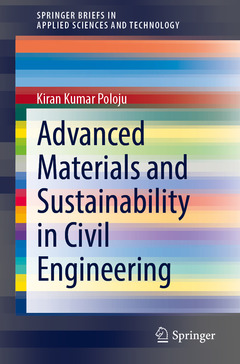Description
Advanced Materials and Sustainability in Civil Engineering, 1st ed. 2022
SpringerBriefs in Applied Sciences and Technology Series
Author: Poloju Kiran Kumar
Language: English
Subjects for Advanced Materials and Sustainability in Civil Engineering:
Keywords
Concrete composition; Bleeding on Concrete; Hardened Concrete; Curing of concrete; Pozzolana Portland Cement; Bond strength; Flexural strength; Acid durability factor; Sorptivity studies; Hypo sludge concrete; Sea shell concrete; Geopolymer Concrete; Self-Compacting Concrete; Nano Silica in concrete
Approximative price 63.29 €
In Print (Delivery period: 15 days).
Add to cartSupport: Print on demand
Description
/li>Contents
/li>Biography
/li>Comment
/li>
1. INTRODUCTION TO CONCRETE
1.1 Constituents of concrete
1.1.1 Importance of the Ingredients of Concrete
1.2 Characteristics of Concrete
1.2.1 Fresh Concrete
1.2.2 Hardened Concrete1.2.3 Workability of Concrete
1.2.4 Stability of Concrete
1.2.5 Segregation of Concrete
1.2.6 Bleeding on Concrete1.2.7 Curing of concrete
1.3 Cement
1.3.1 Manufacturing Process of Cement
1.3.2 Bogues compounds and its significance
1.4 Tests on Cement
1.4.1 Physical Tests1.4.2 Chemical Tests
1.5 Types of Cement
1.5.1 Ordinary portland Cement
1.5.2 Pozzolana Portland Cement
1.6 Aggregate
1.6.1 Fine Aggregate1.6.2 Coarse Aggregate
1.6.3 Tests on Aggregate
1.7 Water
2. TESTS ON HARDENED CONCRETE
2.1 Mechanical Properties of Concrete
2.1.1 Compressive Strength
2.1.2 Split tensile Strength2.1.3 Flexural Strength
2.1.4 Bond Strength
2.2 Durability Properties of Concrete
2.2.1 Acid Attack test
2.2.2 Acid Durability factor2.2.3 Sorptivity Studies
3. ADMIXTURES IN CONCRETE
3.1 Mineral Admixture
3.2 Chemical Admixture
4. DISADVANTAGES OF CEMENT PRODUCTION
4.1 How global warming related to manufacturing process of cement
4.2 Various supplementary cementitious materials used in concrete5. HYPO SLUDGE AS PARTIAL REPLACEMENT OF CEMENT
5.1 Ingredients present in Hypo sludge concrete
5.2 Chemical composition of Hypo sludge compared to cement
5.3 Advantages of using Hypo sludge as partial replacement as cement in concrete
5.4 Illustration- 1- Advancement of Physical Properties of Hypo sludge concrete for M 20 Grade of concrete6. MARBLE POWDER AS PARTIAL REPLACEMENT OF CEMENT
6.1 Ingredients present in concrete
6.2 Chemical composition of marble powder compared to cement
6.3 Advantages of using marble powder as partial replacement as cement in concrete
6.4 Illustration- 2- Determination of strength properties of concrete using Marble Powder as partial replacement as cement in concrete
7. CERAMIC POWDER AS PARTIAL REPLACEMENT OF CEMENT
7.1 Ingredients present in concrete
7.2 Chemical composition of ceramic powder compared to cement7.3 Advantages of using ceramic powder as partial replacement as cement in concrete
7.4 Illustration- 3- Determination of strength properties of concrete using ceramic powder as partial replacement as cement in concrete
8. SEA SHELL AS PARTIAL REPLACEMENT OF CEMENT
8.1 Ingredients present in seas shell concrete
8.2 Advantages of using seashells as partial replacement as fine aggregate in concrete
8.3 Illustration- 4- Advancement of Physical Properties of concrete using sea shell as a partial replacement of fine aggregate in concrete
9. Properties of Concrete as Influenced by Shape and Texture of Fine Aggregate
9.1 Illustration- 5- Advancement of Physical Properties of concrete as Influenced by Shape and Texture of Fine Aggregate
10. TYPES OF CONCRETE
10.1 Geopolymer Concrete10.1.1 Manufacturing process of GPC
10.1.2 Ingredients present in concrete
10.1.3 Significance of the Ingredients of GPC
10.1.4 Chemical composition of GPC10.1.5 Pros and Cons of manufacturing GPC
10.1.6 Preparation of Alkaline Activator
10.1.7 Effect of NaOH on the strength properties of GPC
10.1.8 Effect of Molarity on strength properties of GPC10.1.9 Illustration- 6
10.2 Self-Compacting Concrete
10.2.1 Manufacturing process of SCC
10.2.2 Ingredients present in concrete
10.2.3 Significance of the Ingredients of SCC Illustration- 7- Effect of using Nano Silica in concretePresents detailed concepts of concrete and its development in recent years
Discusses the use of industrial wastes as partial replacement with concrete to reduce the greenhouse effect
Highlights various case studies of using industry wastes as partial replacement of cement in concrete
These books may interest you

Recycling of Biomass Ashes 158.24 €



